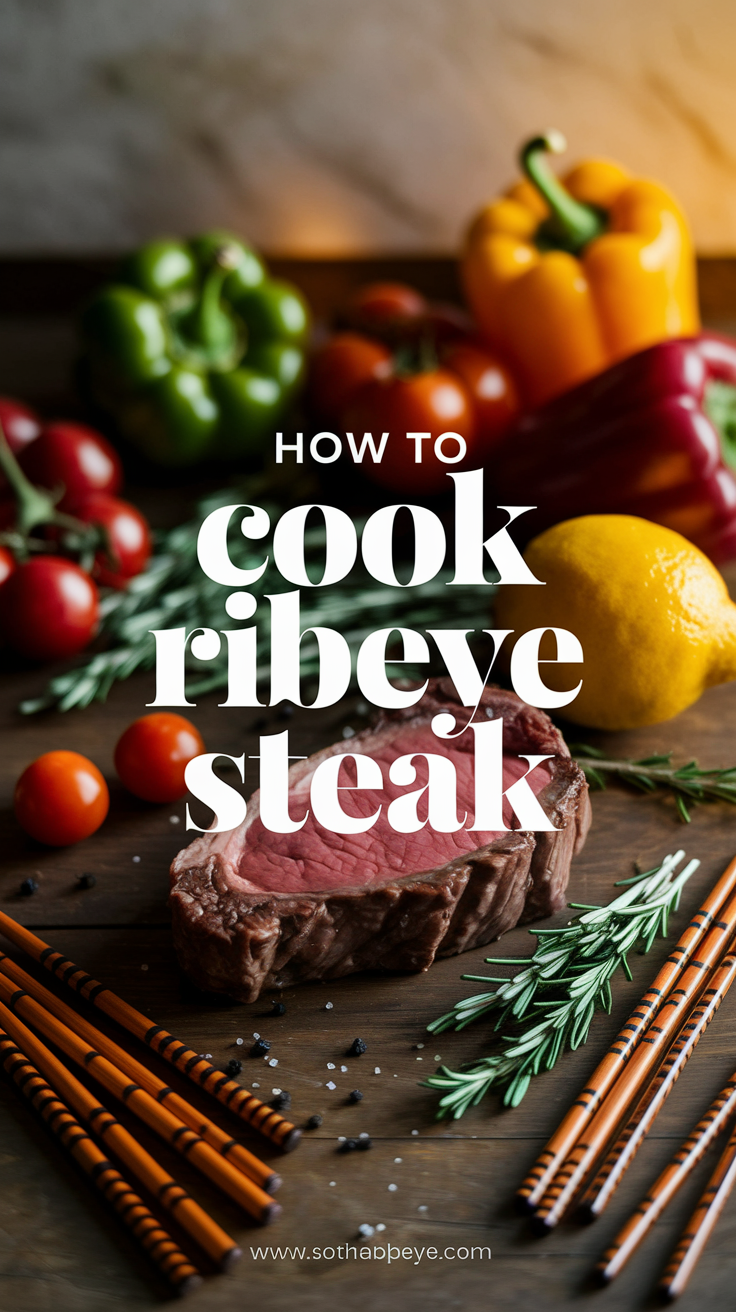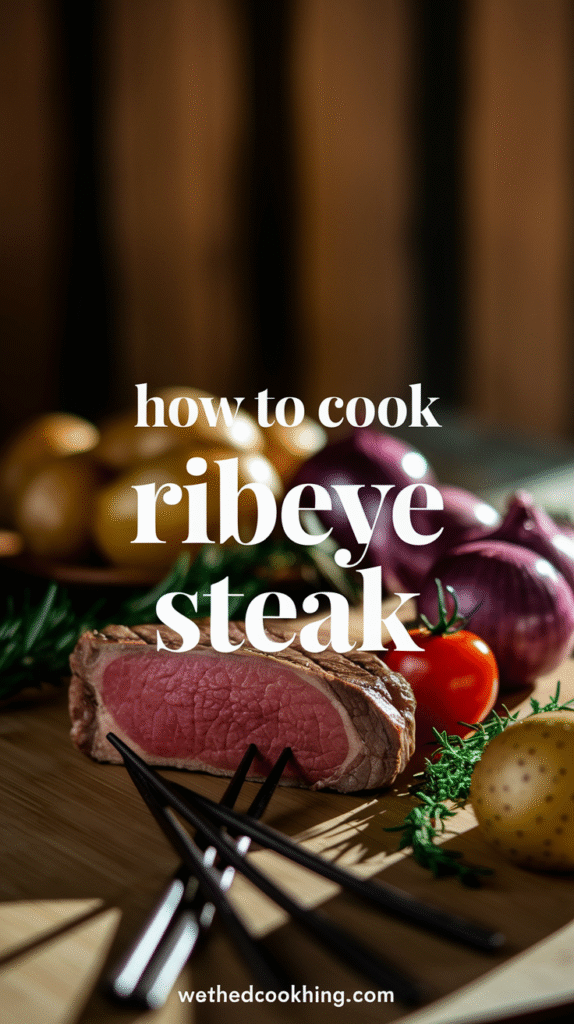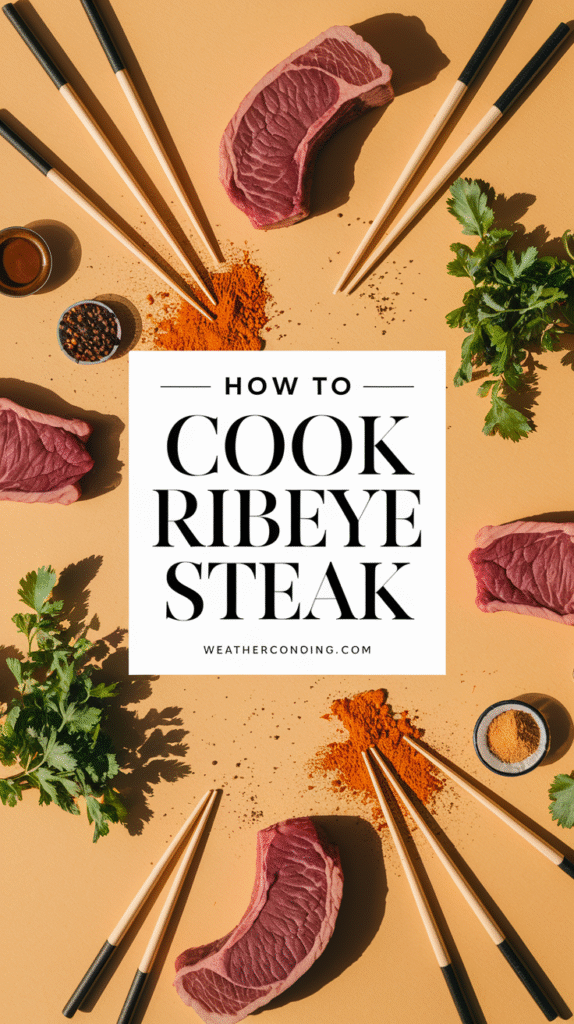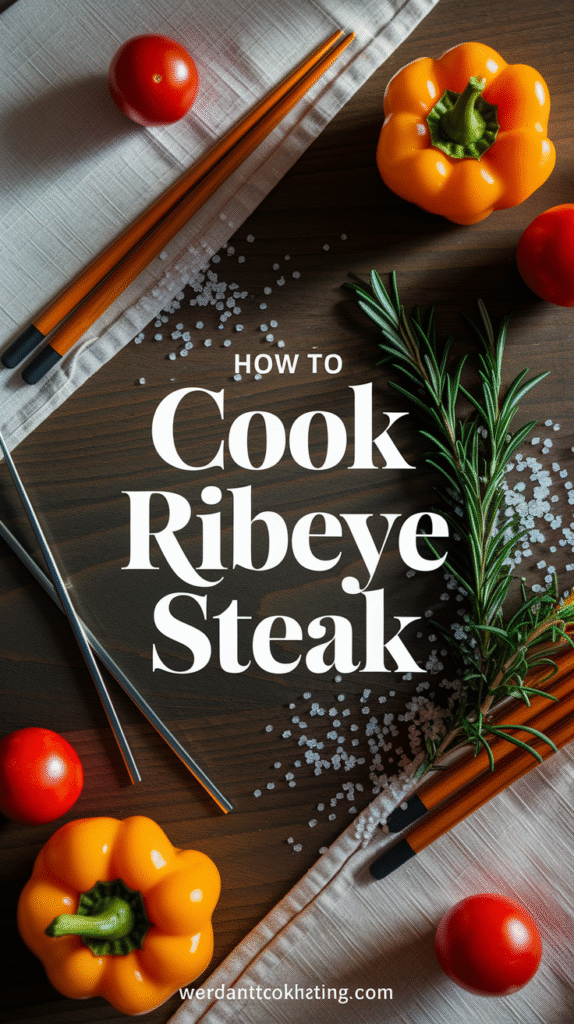Cooking ribeye steak to perfection involves several techniques that can elevate this already delicious cut of beef. Ribeye, known for its marbling and flavor, can be prepared using various methods, each giving unique results. Whether you prefer grilling, pan-searing, or using an oven, mastering these techniques will help you enjoy a mouthwatering steak every time.
Choosing the Right Ribeye Steak
Start with selecting a high-quality ribeye steak. Look for steaks that have good marbling, as the intramuscular fat will render during cooking, adding flavor and juiciness. The thickness is also important; aim for steaks that are at least one inch thick for the best cooking results.
Preparing the Steak
Before cooking, let your ribeye steak sit at room temperature for 30 minutes. This helps ensure even cooking. Pat the steak dry using paper towels to remove excess moisture which can hinder browning. Season generously with kosher salt and freshly cracked black pepper. You can also add garlic powder or your favorite steak rub if desired.
Grilling Ribeye Steak
Grilling is one of the most popular methods for cooking ribeye steaks. Follow these steps for a deliciously grilled steak:
- Preheat the Grill: Preheat your gas or charcoal grill to high heat (around 450-500°F).
- Oil the Grate: Lightly oil the grill grates to prevent sticking.
- Cook the Steak: Place the steak on the hot grill. Cook for about 4-5 minutes on one side without moving it for perfect grill marks.
- Flip and Continue Cooking: Flip the steak and cook for another 3-5 minutes, depending on your preferred doneness.
- Check for Doneness: Use a meat thermometer; 125°F for medium-rare and 135°F for medium.
- Rest the Steak: Remove from the grill and let it rest for at least 5 minutes to allow the juices to redistribute.
Pan-Searing Method
Pan-searing is another fantastic method to cook ribeye steak, giving it a rich, brown crust.
- Heat the Pan: Use a heavy-bottomed skillet (cast iron works best) and heat it over medium-high heat.
- Add Oil: Add a tablespoon of high smoke-point oil (like avocado or grapeseed oil).
- Place the Steak: Once the oil is shimmering, add the ribeye steak to the pan. Sear for about 4-5 minutes.
- Baste: When you flip the steak, add a few tablespoons of butter, rosemary, or thyme for extra flavor. Baste the steak with the melted butter for an additional 2-4 minutes.
- Check the Temperature: Again, make sure to use a thermometer to ensure desired doneness.
- Let it Rest: Rest the steak on a cutting board for about 5-10 minutes.
Oven Method
The oven method is ideal for thicker cuts of ribeye steak. Here’s how to do it:
- Sear First: Start by searing both sides of the ribeye in a hot oven-safe skillet for 2-3 minutes each side to develop a crust.
- Transfer to Oven: Move the skillet to a preheated oven at 400°F, cooking the steak until it reaches your desired internal temperature (about 8-10 minutes).
- Rest: Once cooked, remove the steak from the oven and let it rest.
Essential Tips for Cooking Ribeye Steak
- Always let the steak rest after cooking to preserve juices.
- Use a meat thermometer for consistent results.
- Experiment with different seasonings and marinades for flavor.
- Try finishing the steak with a sprinkle of flaky sea salt for added crunch.
For more detailed recipes and techniques, you can explore Serious Eats or Food Network. With these methods and tips, you’ll be able to cook ribeye steak to perfection, impressing friends and family with each flavorful bite!
Best Seasonings and Marinades for Ribeye Steak
If you want to elevate your ribeye steak to the next level, the right seasonings and marinades can work wonders. Ribeye steak is already a flavorful cut, known for its marbling and tenderness. However, the addition of seasonings and marinades can enhance those natural flavors even further. Here are some of the best options to consider:
Essential Seasonings for Ribeye Steak
When seasoning ribeye steak, simplicity often works best. You want to enhance the meat’s natural flavors without overpowering them. Here are some key seasonings to think about:
- Salt: A good quality sea salt or kosher salt is essential. It draws out the meat’s moisture and helps create a great crust.
- Pepper: Freshly cracked black pepper adds a robust kick. Use it generously to complement the richness of the steak.
- Garlic Powder: A hint of garlic powder can introduce a savory element. It works especially well when combined with herbs.
- Onion Powder: Like garlic, onion powder adds depth without overwhelming the meat.
- Smoked Paprika: For a subtle smokiness, smoked paprika can add a unique layer of flavor.
Herbs That Compliment Ribeye Steak
Fresh or dried herbs can make a significant impact on the overall flavor profile. Here are some herbs that pair beautifully with ribeye steak:
- Rosemary: The piney aroma of rosemary adds a delicious note to beef. Consider using fresh sprigs for marinating or chopping finely to mix with other spices.
- Thyme: This herb offers an earthy flavor that enhances the natural taste of the meat.
- Oregano: Oregano provides a slightly peppery flavor that goes well with beef.
Popular Marinades for Ribeye Steak
Marinating your ribeye steak can amplify its flavors and tenderness. Here are a few popular marinades that work wonderfully:
| Marinade | Main Ingredients | Flavor Notes |
|---|---|---|
| Soy Sauce Marinade | Soy sauce, garlic, ginger, and sesame oil | Umami-rich and salty with a hint of sweetness |
| Balsamic Vinegar Marinade | Balsamic vinegar, olive oil, garlic, and rosemary | Sweet-tart flavor that helps tenderize |
| Citrus Marinade | Lemon or lime juice, olive oil, garlic, and cumin | Bright and zesty profile that cuts through richness |
Each of these marinades not only infuses flavor but can also help in tenderizing the meat, offering a juicy and delicious ribeye steak experience.
Cooking Tips to Maximize Flavor
Besides using seasonings and marinades, how you cook your ribeye can further enhance its taste. Here are some useful tips:
- Bring to Room Temperature: Before cooking, let your ribeye sit out for about 30 minutes. This helps it cook evenly.
- High Heat: Searing the steak on high heat locks in juices and creates a delicious crust.
- Resting is Key: After cooking, allow the steak to rest for at least 5–10 minutes. This helps redistribute juices, making it more tender and flavorful.
When it comes to ribeye steak, taking the time to select the right seasonings and marinades can transform your cooking. Not only will your steak taste better, but you’ll also impress everyone at the dinner table. For more tips on marinades and seasoning, visit Serious Eats or check out Food Network for plenty of recipe inspiration.
With the right approach, you can turn a simple ribeye steak into a memorable meal packed with flavor. Don’t hesitate to experiment with different combinations to find what suits your palate best!
Cooking Ribeye Steak: Grill vs. Pan-Seared
Cooking ribeye steak can be an exciting culinary adventure. Whether you’re grilling outdoors or pan-searing on the stovetop, each method has its own unique benefits. Understanding the differences between these two cooking techniques can elevate your steak game significantly. Here’s a detailed look at both methods so you can choose what suits you best.
Grilling Ribeye Steak
Grilling is a popular method that imparts a smoky flavor to the ribeye steak. Ideal for outdoor enthusiasts, this method leverages direct heat, allowing for quick cooking while retaining juicy tenderness.
Advantages of Grilling
- Flavor: Grilling enhances the natural flavors of the ribeye steak, creating a delicious charred crust.
- Outdoor Experience: Enjoying the grilling process outdoors can make for a fun, social cooking event.
- Speed: Grilling generally cooks the steak faster due to high heat.
- Less Cleanup: If you grill outdoors, you often avoid messy stovetop splatter.
How to Grill Ribeye Steak
Follow these steps for perfect grilled ribeye steak:
- Preheat your grill to high heat.
- Season your ribeye steak generously with salt and pepper.
- Place the steak on the grill, directly over the heat.
- Cook for 4-6 minutes on one side, depending on thickness and desired doneness.
- Flip the steak and continue to grill for another 4-6 minutes.
- Use a meat thermometer: 130°F for medium-rare, 145°F for medium.
- Remove the steak from the grill and let it rest for 5-10 minutes before slicing.
For more grilling tips, check out Grilling Companion.
Pan-Searing Ribeye Steak
Pan-searing ribeye steak provides a rustic flavor with a rich crust while allowing for better control over the cooking process, especially indoors.
Advantages of Pan-Searing
- Control: You can maintain consistent cooking temperatures for even doneness.
- Juiciness: The ribeye often holds on to more moisture when pan-seared.
- Versatility: Cooking indoors means you can take advantage of spices and sauces without worrying about outdoor conditions.
- Ease of Use: No need for a grill or more extensive equipment makes it accessible for many cooks.
How to Pan-Sear Ribeye Steak
To achieve the best results when pan-searing, follow these steps:
- Choose a heavy skillet or cast iron pan and heat it over medium-high heat.
- Add a tablespoon of vegetable oil or butter to the pan.
- Season your ribeye steak as desired.
- Place the steak in the skillet and sear for 4-5 minutes on one side.
- Flip the steak and sear for another 4-5 minutes, basting with the melted butter for flavor.
- Use a meat thermometer: 130°F for medium-rare, 145°F for medium.
- Allow the steak to rest for 5-10 minutes before serving to retain its juices.
Find more pan-searing techniques at Serious Eats.
| Cooking Technique | Flavor | Control | Ideal for |
|---|---|---|---|
| Grilling | Smoky, charred | Moderate | Outdoor events |
| Pan-Searing | Rich, savory | High | Indoor cooking |
Both grilling and pan-searing can result in a beautifully cooked ribeye steak. Your choice will depend on personal preferences, weather conditions, and the cooking environment. Exploring both methods will give you a better understanding of the nuances involved in cooking this delicious cut of meat. So fire up that grill or heat that pan, and enjoy a perfectly cooked ribeye steak!
Understanding Ribeye Steak Cuts and Their Flavors
When it comes to steak, ribeye is often hailed as one of the most flavorful cuts available. Originating from the rib section of the cow, ribeye steak carries a rich marbling of fat, which is key to its taste and tenderness. Understanding the different ribeye cuts can greatly enhance your cooking experience and elevate your dishes.
Different Cuts of Ribeye Steak
Ribeye steaks can be divided into several distinct cuts, each offering unique flavors and textures. Here’s a brief overview:
- Bone-In Ribeye: This cut includes the rib bone, adding extra flavor during cooking. The bone also helps to retain moisture, resulting in a juicier steak.
- Boneless Ribeye: A popular choice for its convenience, this cut is easy to slice and serves well for grilling. It provides a robust flavor without the complication of dealing with bones.
- Ribeye Cap: The ribeye cap, or ‘spinalis dorsi’, is considered the most tender and flavorful part. Its higher fat content leads to a rich, buttery taste.
- Chuck Eye Steaks: Often referred to as the ‘poor man’s ribeye,’ this cut is from the shoulder area and offers a similar flavor at a more affordable price.
Flavor Profile
The enjoyment of eating ribeye steak largely comes from its distinct flavor profile. This flavor comes primarily from the marbling of fat. Here’s what you can expect:
- Rich and Buttery: The high fat content gives ribeye its rich, buttery flavor. The intramuscular fat melts during cooking, enhancing the steak’s overall taste.
- Umami: Ribeye contains natural glutamates, which boosts the savory flavor known as umami. This makes it incredibly satisfying.
- Juiciness: Steak lovers appreciate the juicy texture that ribeye offers. It’s often more forgiving on the grill, as its fat helps to keep it moist.
The Best Cooking Methods
Cooking ribeye steak properly unlocks its full potential. Here are a few highly recommended methods:
- Grilling: Preheat your grill to high heat. Season the steak with salt and pepper, then grill for 4-5 minutes on each side for medium-rare. Use a meat thermometer to check doneness.
- Pan-Searing: Perfect for a stovetop meal, begin by heating a cast-iron skillet until it’s very hot. Add a little oil, then sear the steak on each side for 3-4 minutes. Baste with butter and herbs for added flavor.
- Oven Roasting: Sear the ribeye steak in a skillet, then transfer it to a preheated oven at 400°F (200°C) for about 10-15 minutes, depending on your preferred doneness.
Choosing the Right Ribeye
When shopping for ribeye, quality matters. Here are a few tips to ensure you select the best steak:
- Look for Marbling: The more marbling, the better! Thin white streaks of fat running through the meat indicate higher quality.
- Check the Color: A vibrant red color is ideal. Avoid steaks that appear brown or gray, as this can indicate age.
- Consider Grade: Look for USDA ratings like Prime, Choice, or Select. Prime ribeye is the highest quality but also more expensive.
If you’re eager to dive deeper into the world of ribeye steaks, many culinary websites offer valuable tips and recipes. Consider visiting Serious Eats for in-depth guides.
Ribeye steak is a delicious cut that is versatile in cooking methods and offers a rich flavor profile. Whether you’re grilling, searing, or roasting, knowing the various cuts and their attributes will help you choose and perfect your ribeye experience. So fire up your grill or stove and enjoy the succulent taste of this exquisite steak!
Pairing Wines and Side Dishes with Ribeye Steak
Pairing wines and side dishes with ribeye steak can elevate your dining experience to new heights. The rich flavor and tenderness of ribeye steak call for complementary wines and sides that enhance the meal. Here are some excellent options to consider.
Choosing the Right Wine
The perfect wine can enhance the flavors of ribeye steak. Here are some of the best wine options to consider:
- Cabernet Sauvignon: This full-bodied red wine is a classic choice. Its bold tannins balance the richness of the meat.
- Malbec: With its dark fruit flavors and velvety finish, Malbec pairs wonderfully with the savory notes of ribeye.
- Zinfandel: This medium to full-bodied wine has a fruity profile that complements the steak’s juiciness.
- Syrah/Shiraz: With its spicy and earthy undertones, Syrah adds depth to the overall meal experience.
- Chianti: This Italian red offers bright acidity, cutting through the fat and enhancing the flavors.
When selecting a wine, consider the cooking method of your ribeye steak. If you’re grilling, a smoky wine like Syrah is ideal. For pan-seared steak, consider a bold Cabernet Sauvignon.
Side Dishes That Complement Ribeye Steak
Choosing the right side dishes can make a meal extraordinary. Below are some classic sides that work perfectly with ribeye steak:
- Garlic Mashed Potatoes: Creamy and flavorful, they complement the juicy steak beautifully.
- Grilled Asparagus: The smoky flavor enhances the steak and adds a healthy touch.
- Roasted Brussels Sprouts: Their crispy texture and earthy flavor pair well with ribeye.
- Caesar Salad: The freshness and crunch of romaine lettuce balanced with creamy dressing are delightful.
- Sautéed Mushrooms: Earthy mushrooms enhance the umami flavor of the steak.
Tips for Pairing
To achieve the best pairings, consider the following tips:
- Balance flavors: Choose sides and wines that either contrast or complement the steak’s richness. A light salad can balance a heavy, buttery steak.
- Avoid overpowering flavors: You want your wine and sides to enhance the ribeye’s flavor without overshadowing it.
- Experiment: Don’t hesitate to try new combinations to find what you enjoy most.
- Temperature matters: Serve red wines slightly warmer, around 60-65°F, to bring out their full flavor potential.
Sample Pairing Options
| Wine | Side Dish | Flavor Notes |
|---|---|---|
| Cabernet Sauvignon | Garlic Mashed Potatoes | Rich and velvety |
| Malbec | Grilled Asparagus | Bold and earthy |
| Zinfandel | Roasted Brussels Sprouts | Fruity with a touch of spice |
The right wine and side dishes can transform a simple ribeye steak meal into a gourmet experience. For further exploration on wine pairings, you can refer to Wine Enthusiast or Wine Magazine. Additionally, try visiting Food & Wine for inspiration on side dishes that complement your meal perfectly.
Enjoy the art of pairing your ribeye steak with a delightful wine and sides, and savor the experience with every bite and sip!
Conclusion
Cooking ribeye steak to perfection is an art that combines technique, seasoning, and an understanding of flavors. Whether you choose to grill or pan-sear, the methods we’ve explored ensure that your steak turns out juicy and tender every time. Remember to use the best seasonings and marinades to elevate the natural flavors of the ribeye, allowing the rich marbling to shine through.
Understanding the different cuts of ribeye is essential for maximizing flavor. Each cut offers a unique taste experience, whether you prefer the classic bone-in for added richness or a boneless option for simplicity. With this knowledge, you can confidently select your perfect steak and prepare it in a way that caters to your palate.
Don’t forget about the importance of wine and side dish pairings. A well-chosen wine can enhance your meal; consider a bold red that complements the robust flavor of the ribeye. Additionally, side dishes such as grilled vegetables or creamy mashed potatoes can create a well-rounded dining experience, balancing richness with freshness.
With these guidelines, you are now equipped to cook ribeye steak like a pro. Embrace the process, experiment with different techniques and flavors, and most importantly, enjoy the journey of perfecting this delicious cut of meat. Your taste buds will thank you, and your friends and family will be eager to join you for the next steak dinner!







Leave a Reply